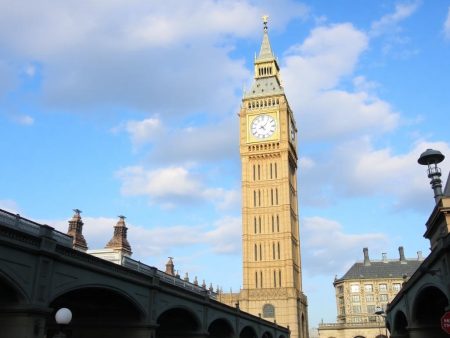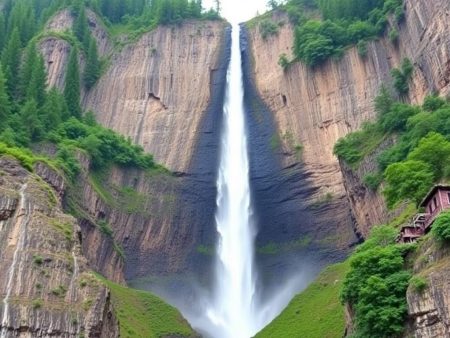Lo skyline di New York City è a dir poco iconico, con le sue imponenti strutture che si ergono come simboli di ambizione e innovazione. Tra queste meraviglie architettoniche, un edificio si erge al di sopra degli altri, rivendicando il titolo di più alto della città. È una testimonianza dell'ingegno umano e un riflesso dello spirito in continua evoluzione di New York.
Questo imponente capolavoro non è solo una questione di altezza: è un mix di tagli
Scopri One World Trade Center: l'edificio più alto di New York e la sua storia iconica
Lo skyline di New York City è a dir poco iconico, con le sue imponenti strutture che si ergono come simboli di ambizione e innovazione. Tra queste meraviglie architettoniche, un edificio si erge al di sopra degli altri, rivendicando il titolo di più alto della città. È una testimonianza dell'ingegno umano e un riflesso dello spirito in continua evoluzione di New York.
Converti l'altezza delle persone, degli edifici, delle montagne e dei monumenti più alti in m, piedi e pollici per confrontarli
0' 0" equivale a 0,0 cm o 0,00 m.
Questo imponente capolavoro non riguarda solo l'altezza: è un mix di design all'avanguardia, storia e uno sguardo al futuro. Che tu sia un abitante del posto o un viaggiatore curioso, la storia dietro l'edificio più alto di New York ti lascerà sicuramente a bocca aperta. Diamo un'occhiata più da vicino a ciò che rende questa struttura così straordinaria.
Panoramica dell'edificio più alto di New York
L'edificio più alto di New York City, One World Trade Center, si erge a un'altezza impressionante di 1.776 piedi (541 metri). Completato nel 2014, è stato progettato dall'architetto David Childs di Skidmore, Owings & Merrill. La sua altezza, che simboleggia l'anno dell'indipendenza americana, lo rende un importante punto di riferimento culturale e storico.
La struttura è composta da 104 piani, di cui 78 destinati ad uso ufficio. Un osservatorio, situato dal 100° al 102° piano, offre viste panoramiche di Manhattan e oltre. L'edificio incorpora elementi di design sostenibile, utilizzando sistemi a risparmio energetico e materiali riciclati.
In totale, il progetto è costato circa $3,9 miliardi, il che lo rende uno dei grattacieli più costosi mai costruiti. Il grattacielo fa parte della più ampia riqualificazione del sito del World Trade Center, svolgendo un ruolo fondamentale nella rivitalizzazione dell'area. La sua combinazione di ingegneria avanzata e rilevanza simbolica ne garantisce il posto come risultato architettonico riconosciuto a livello mondiale.
Progettazione architettonica e caratteristiche
One World Trade Center incarna l'apice del design architettonico moderno. I suoi elementi distintivi fondono estetica, funzionalità e sostenibilità.
Design esterno
L'esterno presenta un design elegante e affusolato composto da otto triangoli isosceli. Queste forme geometriche formano un'elegante struttura ottagonale che culmina in un parapetto in vetro. La facciata è rivestita da 2.000 pannelli di vetro scintillanti che riflettono la luce del sole, mostrando un aspetto dinamico da diverse angolazioni. Al suo apice, una guglia di 408 piedi incorona la torre, fungendo da antenna di comunicazione e contribuendo alla sua altezza simbolica di 1.776 piedi. La base in cemento armato, avvolta in alette di vetro ultra-trasparente, fornisce sia fascino visivo che sicurezza.
Funzionalità e disposizione degli interni
Gli interni danno priorità a usabilità e versatilità. I 78 piani degli uffici sono caratterizzati da spazi senza colonne che consentono layout flessibili per gli inquilini. Sistemi HVAC avanzati e finestre dal pavimento al soffitto massimizzano l'efficienza energetica e il flusso di luce naturale. La base del podio ospita strutture commerciali, mentre i piani più alti vantano una terrazza panoramica che si estende dal 100° al 102° piano. I visitatori accedono alla terrazza tramite ascensori ad alta velocità, che mostrano immagini digitali immersive durante il transito. Le caratteristiche di sicurezza includono scale extra-large, chiusure delle scale pressurizzate e strutture fortificate. La certificazione LEED Gold evidenzia i suoi principi di progettazione sostenibili ed efficienti.
Significato storico
One World Trade Center ha una profonda importanza storica, simboleggiando la resilienza e l'unità dopo gli eventi dell'11 settembre 2001. Costruito sul sito delle ex Torri Gemelle, è sia un omaggio a coloro che sono scomparsi sia una testimonianza dello spirito duraturo di New York City. La sua altezza di 1.776 piedi riflette l'anno della firma della Dichiarazione di Indipendenza, ancorando il suo legame con la storia americana.
La ricostruzione del sito del World Trade Center ha segnato un momento cruciale per il recupero architettonico e culturale negli Stati Uniti. Completata nel 2014, la torre è diventata un simbolo globale di progresso e ricordo. L'incorporazione del National September 11 Memorial & Museum nel sito sottolinea ulteriormente il suo ruolo nel preservare l'eredità e promuovere la riflessione.
Fulcro dello skyline di Lower Manhattan, il One World Trade Center unisce il fascino storico a un design all'avanguardia, diventando un'icona intramontabile della città e della nazione.
Confronto con altri grattacieli di New York
One World Trade Center si distingue come l'edificio più alto e simbolicamente più significativo di New York City. Confrontando le sue caratteristiche con altri grattacieli, si evidenzia ciò che lo definisce un'icona moderna.
Attributi unici
One World Trade Center supera gli altri grattacieli di New York in termini di design, simbolismo e innovazione sostenibile. A differenza dell'Empire State Building, che riflette l'estetica Art Déco degli anni '30, la sua architettura contemporanea integra materiali avanzati come vetro e acciaio ad alte prestazioni. Mentre il Chrysler Building è rinomato per la sua guglia ornata, la guglia di 408 piedi di One World Trade Center funge anche da antenna funzionale.
Il significato culturale del One World Trade Center è ineguagliabile. Posizionato su Ground Zero e comprendente il Memoriale dell'11 settembre, ha un peso storico assente in strutture come 30 Hudson Yards o 432 Park Avenue. Anche la sostenibilità lo distingue, poiché progetti come la Central Park Tower non hanno caratteristiche equivalenti alla sua certificazione LEED Gold.
Altezza e misure
One World Trade Center è in cima alla lista dei grattacieli di New York con un'altezza impressionante di 1.776 piedi, inclusa la sua guglia. Al contrario, la Central Park Tower, la seconda più alta, misura 1.550 piedi e si concentra principalmente sull'uso residenziale. L'Empire State Building, da tempo emblema dello skyline della città, si erge a 1.454 piedi con la sua guglia, significativamente più bassa di One World Trade Center.
30 Hudson Yards misura 1.296 piedi, classificandosi come un altro importante contendente. Tuttavia, la sua enfasi sugli spazi ad uso misto e sullo sviluppo urbano differisce dalla risonanza culturale del One World Trade Center. Il Chrysler Building, noto per la sua corona decorativa, misura solo 1.046 piedi, esemplificando un approccio storico piuttosto che funzionale all'altezza.
| Grattacielo | Altezza (piedi) | Utilizzo primario |
|---|---|---|
| Un centro commerciale mondiale | 1,776 | Ufficio, osservazione, vendita al dettaglio |
| Torre del parco centrale | 1,550 | Residenziale |
| Edificio dell'Empire State | 1,454 | Ufficio, osservazione |
| 30 cantieri Hudson | 1,296 | Ufficio, vendita al dettaglio, osservazione |
| Edificio Chrysler | 1,046 | Ufficio |
Esperienza dei visitatori e accessibilità
One World Trade Center offre ai visitatori opportunità senza pari per vivere lo skyline di New York City e la sua ricca storia. Varie attrazioni e servizi garantiscono accessibilità e coinvolgimento per tutti i visitatori.
Ponte di osservazione
Il One World Observatory occupa dal 100° al 102° piano dell'edificio. Gli ospiti possono godere di viste mozzafiato a 360 gradi su Manhattan, i quartieri limitrofi e persino parti del New Jersey. Gli ascensori ad alta velocità, noti come SkyPods, trasportano i visitatori al ponte di osservazione in soli 47 secondi, dotati di schermi LED dal pavimento al soffitto che mostrano un time-lapse virtuale dell'evoluzione dello skyline di New York. Display interattivi e guide digitali migliorano l'esperienza panoramica, fornendo informazioni sui punti di riferimento locali.
Tour e attrazioni
One World Trade Center offre visite guidate e mostre interattive per arricchire l'esperienza dei visitatori. I programmi educativi approfondiscono le innovazioni architettoniche del sito, il significato storico e l'impatto culturale. Il Global Welcome Center accoglie gli ospiti all'inizio della loro visita, utilizzando tecnologie all'avanguardia per evidenziare la diversità culturale della città. Inoltre, le attrazioni in loco includono un raffinato ristorante, ONE Dine, e spazi commerciali che soddisfano una varietà di interessi. Ampie sistemazioni garantiscono l'inclusività per le persone con difficoltà motorie, problemi di vista o altri requisiti di accessibilità.
Aspetti ambientali e di sostenibilità
One World Trade Center integra pratiche sostenibili per ridurre al minimo l'impatto ambientale. La sua certificazione LEED Gold riflette l'impegno dell'edificio verso l'efficienza energetica e la sostenibilità delle risorse. Il design incorpora sistemi avanzati per ridurre il consumo energetico e ottimizzare la qualità dell'aria interna.
Materiali riciclati, tra cui acciaio e cemento, sono stati ampiamente utilizzati nella costruzione per ridurre la dipendenza dalle risorse vergini. La facciata in vetro massimizza la luce naturale, riducendo la necessità di illuminazione artificiale durante il giorno. Le finestre dal pavimento al soffitto migliorano l'efficienza energetica e il comfort degli occupanti.
Le caratteristiche di conservazione dell'acqua includono dispositivi a basso flusso e un sistema di raccolta dell'acqua piovana. L'acqua raccolta supporta la progettazione del paesaggio e la manutenzione, riducendo la pressione sulle forniture idriche comunali. L'edificio integra tetti verdi per isolare gli spazi e mitigare il calore urbano.
Gli efficienti sistemi HVAC creano un clima interno confortevole con un consumo energetico ridotto. Le tecnologie avanzate tracciano e gestiscono l'elettricità, garantendo la sostenibilità operativa. Questi sistemi contribuiscono in modo significativo alla riduzione dell'impronta di carbonio della struttura.
Conclusione
One World Trade Center si erge come un potente simbolo di resilienza, innovazione e progresso. Il suo design sorprendente, il significato storico e l'impegno per la sostenibilità lo rendono un vero capolavoro dell'architettura moderna. Oltre alla sua imponente altezza, offre ai visitatori la possibilità di entrare in contatto con il passato, il presente e il futuro di New York City attraverso viste mozzafiato ed esperienze significative.
Essendo l'edificio più alto di New York City, occupa un posto unico nello skyline e nei cuori di chi lo visita. Che venga ammirato da lontano o esplorato da vicino, One World Trade Center continua a ispirare e ad affascinare, incarnando lo spirito di una città che non smette mai di puntare al cielo.
Domande frequenti
Qual è l'edificio più alto di New York City?
One World Trade Center è l'edificio più alto di New York City, con i suoi 1.776 piedi (541 metri). È stato completato nel 2014 e simboleggia l'innovazione, la resilienza e l'anno dell'indipendenza americana.
Qual è il significato dell'altezza del One World Trade Center?
L'altezza di 1.776 piedi richiama l'anno della firma della Dichiarazione d'Indipendenza, rendendo l'edificio un simbolo culturale e storico di libertà e unità.
Cosa rende il One World Trade Center unico nel suo genere?
L'edificio presenta un esterno elegante e affusolato, composto da otto triangoli isosceli, ed è rivestito da 2.000 pannelli di vetro. Una guglia di 408 piedi incorona la struttura, fungendo sia da antenna di comunicazione che da simbolico miglioramento della sua altezza.
Quanti piani ha il One World Trade Center?
Il One World Trade Center ha 104 piani, di cui 78 adibiti a uffici, mentre dal 100° al 102° piano si trovano terrazze panoramiche che offrono viste su Manhattan.
Qual è lo scopo della guglia del One World Trade Center?
La guglia funge da antenna di comunicazione alta 123 metri e costituisce un elemento fondamentale del design dell'edificio, sottolineandone ulteriormente il significato simbolico e funzionale.
Com'è l'esperienza al One World Observatory?
Il One World Observatory, situato tra il 100° e il 102° piano, offre una vista a 360 gradi di Manhattan e dispone di ascensori SkyPod ad alta velocità, display interattivi e visite guidate che arricchiscono la conoscenza dei visitatori sullo skyline e sulla storia della città.
Il One World Trade Center presenta caratteristiche sostenibili?
Sì, One World Trade Center ha ottenuto la certificazione LEED Gold, incorporando caratteristiche quali sistemi HVAC a risparmio energetico, materiali riciclati, sistemi di risparmio idrico e finestre a tutta altezza per l'ingresso della luce naturale.
Quanto è costato costruire il One World Trade Center?
La costruzione del One World Trade Center è costata circa 1,4 miliardi di sterline, rendendolo uno dei grattacieli più costosi mai costruiti.
Dove si trova il One World Trade Center?
Il One World Trade Center è ubicato sul sito delle ex Torri Gemelle, a Ground Zero, nella Lower Manhattan, New York City.
Cosa simboleggia il One World Trade Center?
Oltre alla sua altezza e al suo design, One World Trade Center simboleggia la resilienza, il progresso e il ricordo delle vite perse durante gli attacchi dell'11 settembre 2001. Si erge come una testimonianza dello spirito duraturo di New York City.
Qual è il confronto tra One World Trade Center e l'Empire State Building?
Mentre l'Empire State Building rispecchia lo stile Art Déco degli anni '30, il One World Trade Center è caratterizzato da un'architettura moderna, materiali all'avanguardia, una guglia funzionale e un'importanza culturale senza pari grazie alla sua posizione a Ground Zero.
Qual è il livello di accessibilità per i visitatori al One World Trade Center?
One World Trade Center è accessibile alle persone con difficoltà motorie, è dotato di ascensori per raggiungere i piani superiori e ospita attrazioni come il Global Welcome Center, ristoranti raffinati e spazi commerciali.
Perché il One World Trade Center è storicamente importante?
È stato costruito sul sito delle ex Torri Gemelle e funge da memoriale per le vittime dell'11 settembre, simboleggiando la resilienza e l'unità dell'America; il vicino National September 11 Memorial & Museum ne preserva l'eredità.
I visitatori possono cenare o fare acquisti al One World Trade Center?
Sì, l'edificio offre ai visitatori punti di ristoro in loco, tra cui un raffinato ristorante, e spazi commerciali all'interno della sua base a cui possono accedere i visitatori.
In che modo il One World Trade Center influisce sullo skyline di New York City?
Essendo l'edificio più alto di New York City, il One World Trade Center domina lo skyline, simboleggiando innovazione e resilienza e valorizzando al contempo l'importanza architettonica di Lower Manhattan.





